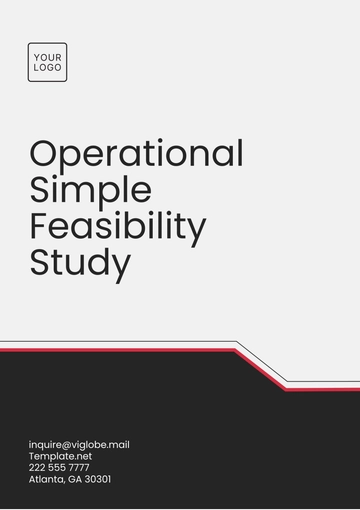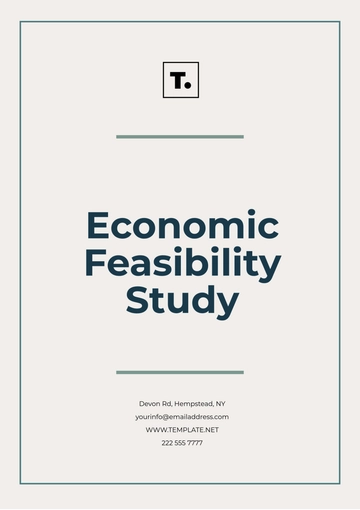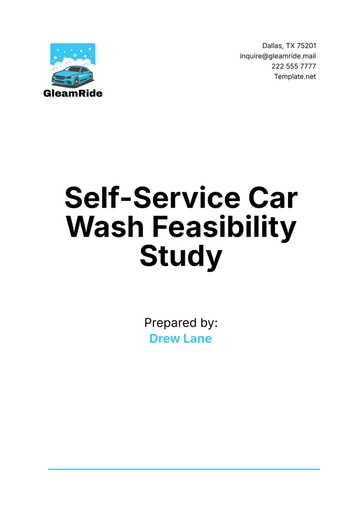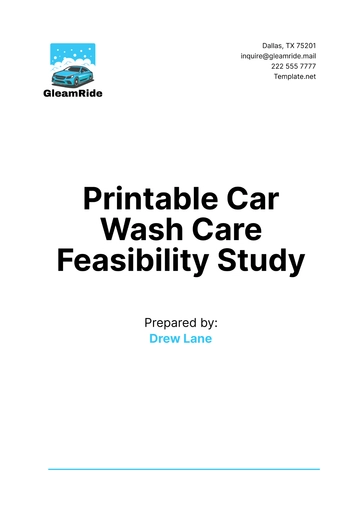Free Marketing Campaign-wise Financial Feasibility Study
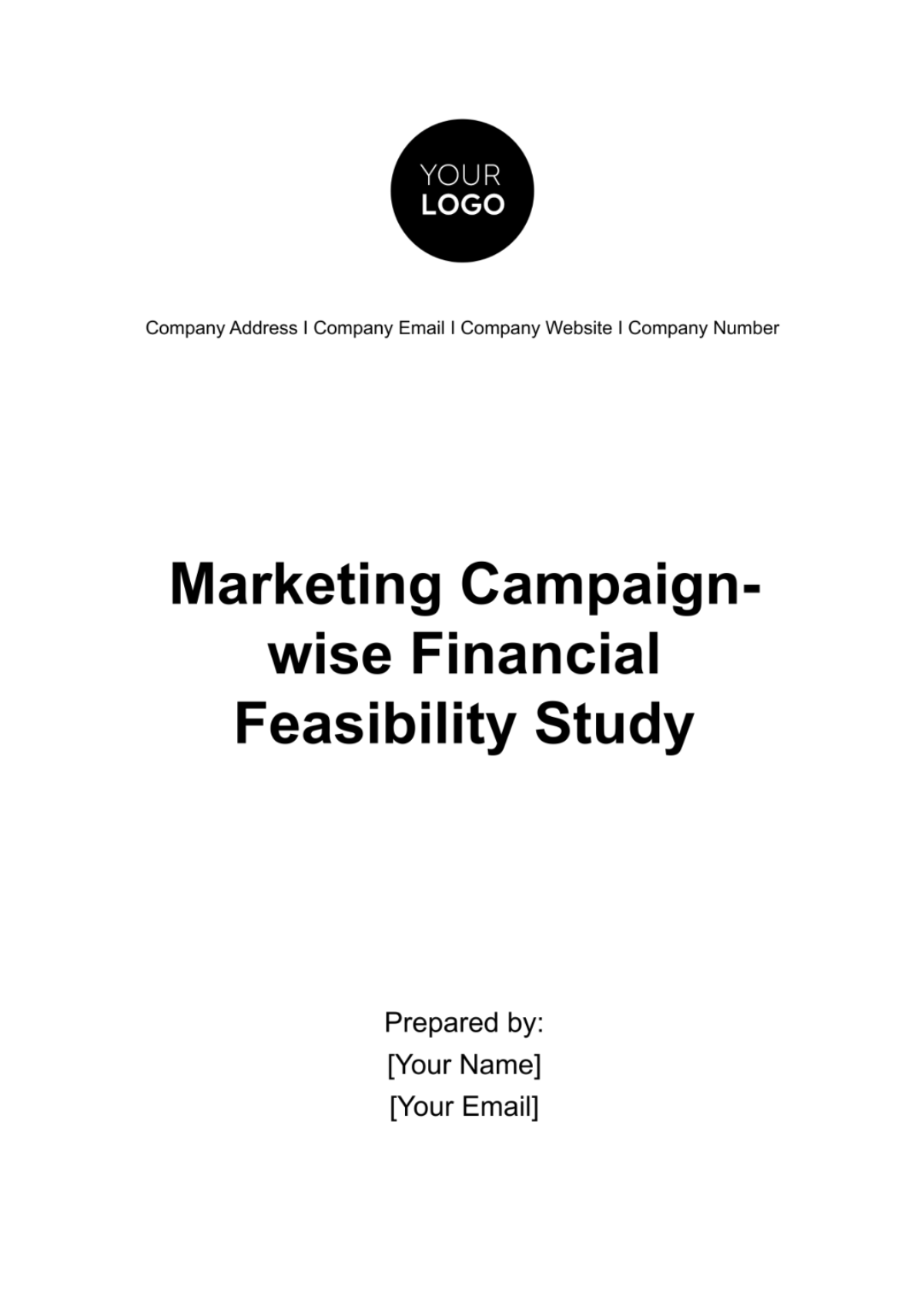
Campaign Name: [Campaign Name]
Objective
The primary objective of this feasibility study is to comprehensively evaluate the financial viability of launching a new product during the spring season with the following key objectives:
Market Share Increase: Our foremost goal is to achieve a substantial increase in market share. We aim for a [00]% growth in market share within the first quarter of the campaign. This strategic objective aligns with our broader business goals and signifies a significant step toward establishing our product as a market leader.
Product Launch Success: Beyond market share growth, we intend to ensure the successful launch of the new product. This includes not only achieving favorable financial returns but also creating brand awareness, capturing consumer interest, and laying a strong foundation for the product's continued success in subsequent quarters.
Optimized Budget Utilization: One of our core objectives is to demonstrate a judicious allocation of resources. We aim to maximize the impact of our campaign while staying within the $[00,000] budget. This objective emphasizes cost-efficiency and disciplined financial management.
Competitive Edge: In the highly competitive market landscape, we seek to gain a competitive edge by strategically positioning our product. Our objective is to differentiate our offering and create a compelling value proposition that attracts new customers and retains existing ones.
Customer Engagement: We aim to enhance customer engagement throughout the campaign. Our objective is to create a seamless and positive customer experience, both online and offline, fostering brand loyalty and encouraging repeat purchases.
Real-time Adaptation: In an ever-evolving market, our objective is to be agile and adaptable. We will continuously monitor campaign performance and consumer feedback to make real-time adjustments and optimize our marketing strategy for maximum effectiveness.
Budget Allocation
Category | Description | Amount |
Total Budget | This budget represents the complete financial commitment for the campaign. It includes all expenses associated with marketing efforts, product launch, and personnel. | $20,000 |
Advertising and Promotion | The largest portion of the budget is allocated to advertising and promotion. This includes expenses related to online advertisements, social media promotion, pay-per-click campaigns, and traditional media advertising. | |
Personnel Expenses | Personnel expenses encompass salaries, wages, and benefits for the marketing team. This team is responsible for executing the campaign, managing content creation, and overseeing advertising efforts. | |
Miscellaneous Expenses | A portion of the budget is set aside for unforeseen or miscellaneous costs that may arise during the campaign. This flexibility ensures that the campaign can adapt to unexpected opportunities or challenges. | |
Sale Price per Unit | The sale price per unit is strategically determined, considering market pricing strategies and product value. | |
Projected Revenue | The projected revenue is calculated by multiplying the projected sales volume by the sale price per unit. |
Cost Analysis
Category | Description | Amount |
Advertising Costs | Advertising costs cover expenses related to creating and placing advertisements across various marketing channels. These expenses include ad design, media placement, and associated fees. | $30,000 |
Creative Development Costs | Creative development costs are associated with designing and producing marketing materials. This includes graphic design, video production, content creation, and related expenses. | |
Personnel Expenses (Salaries and Benefits) | Personnel expenses include salaries, wages, and benefits for the marketing team. This team is responsible for executing the campaign, content creation, and campaign management. | |
Miscellaneous Expenses | Miscellaneous expenses are set aside for unforeseen costs that may arise during the campaign. These expenses may include last-minute opportunities, adjustments, or unanticipated challenges. | |
Total Campaign Costs | $[00,000] | |
ROI Calculations
ROI = (Net Profit / Total Costs) * 100
ROI (Return on Investment) is a crucial metric for assessing the campaign's financial performance.
Net Profit = $[000,000] - $[000,000] = $[00,000]
Net profit represents the difference between the projected revenue and the total campaign costs.
ROI = ($[00,000] / $[00,000]) * 100
In this case, the ROI is calculated to be 100%, indicating that for every dollar invested, the campaign is expected to yield a dollar in profit.
Break-even Analysis
Break-even Point = Total Costs / (Sale Price per Unit - Variable Cost per Unit)
The break-even point is the number of units that must be sold to cover campaign costs and begin generating a profit.
Variable Cost per Unit = ($[00,000] - $[00,000]) / [0,000] = $[0] per unit
The variable cost per unit includes all expenses directly related to product production and excludes advertising costs.
Break-even Point = $[00,000] / ($[00] - $[0])
Based on these calculations, the campaign must sell [0,000] units to reach the break-even point.
Risk Assessment
Market competition may impact sales.
Competitor product launches and marketing efforts may affect the campaign's performance and market share increase.
Changes in advertising costs could affect ROI.
Fluctuations in advertising costs, such as increased ad rates, may impact the campaign budget and, consequently, the ROI.
Weather conditions could influence product demand.
As this is a spring product launch, adverse weather conditions could influence consumer demand. Contingency plans should be in place to mitigate potential weather-related challenges.
Sensitivity Analysis
The sensitivity analysis is a critical component of this financial feasibility study. It involves exploring a range of scenarios to understand how variations in key factors can influence the campaign's financial outcomes. By conducting a sensitivity analysis, we gain a deeper insight into the campaign's robustness and prepare ourselves for a spectrum of potential challenges and opportunities.
A. Key Sensitivity Factors:
Advertising Spend: We will assess how changes in advertising spend affect the campaign's performance. By examining scenarios with higher and lower advertising costs, we can determine the campaign's responsiveness to budget adjustments and potential shifts in ROI.
Product Price: Variations in the sale price per unit will be explored to understand their impact on revenue. We will examine scenarios with higher and lower pricing to assess the campaign's sensitivity to changes in consumer pricing preferences.
Market Demand Fluctuations: A significant sensitivity factor is the potential fluctuation in market demand, which can be influenced by various external factors, such as consumer trends, economic conditions, and competitive offerings. We will consider scenarios where market demand exceeds projections as well as scenarios where demand falls below expectations.
Competitive Responses: We will evaluate how competitors respond to our campaign and product launch. Scenarios involving increased competition, price wars, or competitive product launches will be considered to assess their impact on sales and market share.
Operational Efficiency: Sensitivity to operational efficiency will be examined. Scenarios with improved operational efficiency and cost reduction will be compared to scenarios where operational challenges arise.
B. Objectives of the Sensitivity Analysis:
Risk Mitigation: By exploring a range of potential scenarios, we aim to identify risks and uncertainties that could impact the campaign's financial feasibility. This allows us to develop risk mitigation strategies and contingency plans to address unexpected challenges.
Optimization of Resources: The analysis helps us make informed decisions about resource allocation. For instance, if we discover that the campaign is highly sensitive to changes in advertising spend, we can proactively adjust the budget to maintain financial viability.
Strategic Planning: Understanding how different factors influence the campaign's financial performance informs our strategic planning. We can adapt our marketing strategy based on the insights gained from the sensitivity analysis.
Improved Decision-Making: The sensitivity analysis equips us with a more comprehensive view of potential outcomes, enabling us to make more informed decisions about the campaign's budget, marketing tactics, and risk management.
C. Scenarios to be Explored:
Best-Case Scenario: This scenario will consider factors that are most favorable to the campaign, such as high demand, cost-effective advertising, and strong competitive positioning.
Worst-Case Scenario: Conversely, this scenario will examine the worst-case outcomes, including decreased demand, high advertising costs, and aggressive competitive responses.
Base Case Scenario: The base case represents the most likely scenario based on current market conditions and projections. It serves as a benchmark for comparison with other scenarios.
Incremental Changes: Various incremental changes, such as a 5% increase or decrease in advertising spend or product price, will be explored to understand the campaign's sensitivity to modest variations.
Through this comprehensive sensitivity analysis, we aim to ensure that our financial feasibility study accounts for a wide range of possibilities, enabling us to make data-driven decisions, effectively manage risks, and optimize our campaign strategy to maximize success. This analytical approach helps us be prepared for any challenges that may arise during the Spring Product Launch Campaign.
Marketing Metrics
Customer Acquisition Cost (CAC):
CAC is a critical metric that calculates the cost associated with acquiring a new customer. It considers all marketing expenses related to customer acquisition.
Customer Lifetime Value (CLV):
CLV estimates the long-term value a customer brings to the business. It provides insights into the profitability of retaining customers over time.
Timeline and Milestones
Launch Date: March 1st
The campaign is scheduled to align with the start of the spring season, capitalizing on seasonal consumer preferences.
Milestones: Monitor weekly sales, website traffic, and customer engagement.
Setting specific milestones allows for real-time assessment of campaign performance. Adjustments to the marketing strategy can be made based on the achievement of these milestones.
Recommendations
Based on the comprehensive analysis of the Spring Product Launch Campaign's financial feasibility, a series of recommendations have been formulated to guide the execution of the campaign and maximize its chances of success. These recommendations draw upon the study's findings and aim to address key areas that can enhance the campaign's overall effectiveness and financial performance.
Continuous Monitoring and Adaptation: The financial feasibility study has highlighted the campaign's sensitivity to various factors, including market competition and changes in advertising costs. Therefore, it is recommended that we implement a robust monitoring system to track key performance indicators in real-time. Regularly assess campaign progress, website traffic, and consumer engagement to adapt the marketing strategy swiftly in response to changing conditions.
Cost-Efficiency and Budget Optimization: Given the campaign's budget constraints, it is crucial to maintain cost-efficiency. Continuously evaluate advertising channels to identify the most cost-effective options. Allocate budget resources to strategies that demonstrate a strong return on investment, as highlighted in the sensitivity analysis.
Competitive Analysis and Response Planning: Monitor competitive responses closely. Should competitors launch similar products or engage in aggressive marketing tactics, be prepared with well-defined response strategies. Differentiation and the clear communication of the unique value proposition of our product are essential.
Customer Engagement and Experience Enhancement: Focus on creating a seamless and positive customer experience throughout the campaign. From website navigation to customer support, every interaction should be designed to foster brand loyalty. Engaging content, clear product information, and responsive customer service are key components.
Pricing Strategy Evaluation: Reevaluate the pricing strategy based on market dynamics and consumer feedback. If the sensitivity analysis indicates that price changes could significantly impact ROI, consider price adjustments, promotional strategies, or bundling options to attract and retain customers.
Long-Term Growth Perspective: While the immediate objective is the success of the spring campaign, keep the long-term perspective in mind. Plan for the post-launch phase, including strategies for customer retention, product enhancements, and future expansion. Leverage the campaign's success to establish a solid foundation for ongoing growth.
Risk Mitigation and Contingency Plans: Develop comprehensive contingency plans to address unforeseen challenges. Identify specific risks, such as adverse weather conditions or sudden market shifts, and establish strategies to mitigate these risks while ensuring the campaign remains on course.
Customer Lifetime Value Enhancement: Focus on increasing customer lifetime value through strategies such as upselling, cross-selling, and loyalty programs. Calculate the lifetime value of each customer segment to better understand the potential long-term financial impact of acquiring and retaining customers.
Resource Allocation Flexibility: Be prepared to reallocate resources based on performance. If specific marketing channels or strategies demonstrate superior results, consider shifting resources to capitalize on these opportunities.
The success of the Spring Product Launch Campaign hinges on the ability to execute a well-informed, adaptable, and cost-effective strategy. By following these recommendations and maintaining a proactive approach to campaign management, we can maximize the campaign's potential for financial success while effectively navigating potential challenges and uncertainties in the marketplace.
- 100% Customizable, free editor
- Access 1 Million+ Templates, photo’s & graphics
- Download or share as a template
- Click and replace photos, graphics, text, backgrounds
- Resize, crop, AI write & more
- Access advanced editor
Looking to launch your next marketing campaign with confidence? Look no further than Template.net's Marketing Campaign-wise Financial Feasibility Study Template. This editable and customizable tool is your key to strategic success. Crafted to perfection, it's editable in our Ai Editor Tool, ensuring precision and ease. Elevate your campaign planning today and make every decision count!





